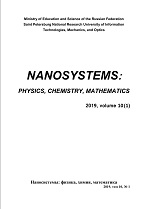|
This article is cited in 12 scientific papers (total in 12 papers)
CHEMISTRY AND MATERIAL SCIENCE
Synthesis of GdFeO$_{3}$ nanoparticles via low-temperature reverse co-precipitation: the effect of strong agglomeration on the magnetic behavior
Ya. Albadiab, K. D. Martinsonc, A. V. Shvidchenkoc, I. V. Buryanenkod, V. G. Semenove, V. I. Popkovc
a Saint Petersburg State Institute of Technology, St. Petersburg, 190013, Russia
b Al-Baath University, Homs, 77, Syria
c Ioffe Institute, St. Petersburg, 194021, Russia
d Peter the Great St. Petersburg Polytechnic University, St. Petersburg, 195251, Russia
e Saint Petersburg State University, Petergof, St. Petersburg, 198504, Russia
Abstract:
Gadolinium orthoferrite (GdFeO$_{3}$) seems to have potential as a dual-modal contrast agent for magnetic resonance imaging (MRI), thus its preparation in the form of ultrafine superparamagnetic nanoparticles is currently of great interest. In this work, nanocrystalline GdFeO$_{3}$ was successfully synthesized by the heat treatment (750$^{\circ}$C, 4 h) of gadolinium and iron(III) hydroxides reversely co-precipitated at low temperature (0$^{\circ}$C). Initial and resulting powders were analyzed by EDX, SEM, PXRD, Mössbauer spectroscopy, vibration magnetometry, etc. Gadolinium orthoferrite was formed as isometric nanocrystals with an average size of 23$\pm$3 nm, which were strongly agglomerated into clusters of about 200 nm in diameter. It was shown that the individual GdFeO$_{3}$ nanocrystals are superparamagnetic, but in the cluster form, they exhibit a collective weak ferromagnetic behavior. After ultrasonic-assisted disintegration of GdFeO$_{3}$ to a colloidal solution form, these clusters remained stable due to their strong agglomeration and low zeta potential value of 1 mV. Thus, it is concluded that the further use of the synthesized GdFeO$_{3}$ nanoparticles as a basis of MRI contrast agents will be possible only after the suppression of their clustering.
Keywords:
gadolinium orthoferrite, nanoparticles, colloidal solutions, magnetic resonance imaging, contrast agents.
Received: 03.04.2020
Citation:
Ya. Albadi, K. D. Martinson, A. V. Shvidchenko, I. V. Buryanenko, V. G. Semenov, V. I. Popkov, “Synthesis of GdFeO$_{3}$ nanoparticles via low-temperature reverse co-precipitation: the effect of strong agglomeration on the magnetic behavior”, Nanosystems: Physics, Chemistry, Mathematics, 11:2 (2020), 252–259
Linking options:
https://www.mathnet.ru/eng/nano522 https://www.mathnet.ru/eng/nano/v11/i2/p252
|

|




 Contact us:
Contact us: Terms of Use
Terms of Use
 Registration to the website
Registration to the website Logotypes
Logotypes







 Citation in format
Citation in format 
